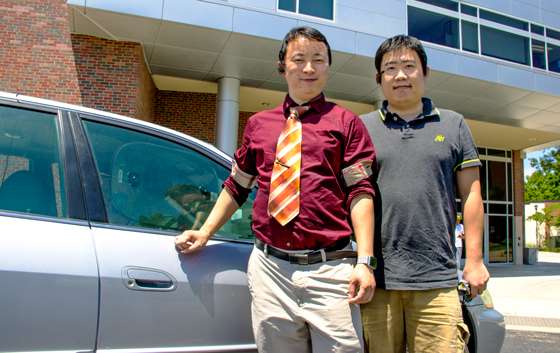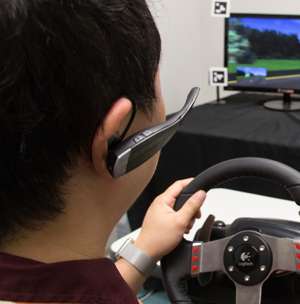Device could detect driver drowsiness, make roads safer

Drowsy driving injures and kills thousands of people in the United States each year. A device being developed by Vigo Technologies Inc., in collaboration with Wichita State University professor Jibo He and graduate students Long Wang, Christina Knopp and Utkarsh Ranjan, could alert drowsy drivers and avoid potential accidents.
He, director of WSU's Human Automation Interaction Lab, has teamed up with California-based Vigo Technologies to design and manufacture the device, a Bluetooth headset that fits on one ear and points an infrared sensor toward the eye to detect blinks, a commonly used indicator of driver drowsiness. It also monitors head movements.
The combined data is transmitted to a smartphone. If drowsiness is detected, the headset will vibrate, flash and beep to alert the driver. A mobile app that allows users to track their alertness level and customize settings such as the sensitivity of the device is provided with the headset.
Vigo Technologies has filed a patent for the device.
"This will provide a new and cost-effective approach to monitor driver drowsiness and help improve driving safety," says He.
Making roadways safer
Insurance companies and information technology companies have been trying hard to develop systems to monitor driver drowsiness, He says.
Traditionally, researchers have used a camera or electrodes to detect eye blinks, but the camera depends on the lighting condition, posture and skin color, and a camera often has a limited field of view to capture eye blinks. And an electrodes-based drowsiness detection system often requires reliable attachment of the electrodes to the skin, which is unreliable, uncomfortable and costly, He says.

This new device, He says, is one of the first scientific attempts to use sensors to detect eye blinks for drowsiness monitoring.
"A nonintrusive, cost-effective wearable technology that is capable of reliably detecting drowsiness in drivers could help to prevent accidents and lower fatalities related to drowsy driving, making roadways safer," He says.
So far, the group has conducted a three-hour simulated driving study to see how drowsiness influences driving performance and the feasibility of using the sensor.
He has also finished an on-road driving study to evaluate the Vigo Bluetooth headset to monitor driver fatigue. The study was carried out using a Honda vehicle, donated by Debra Franklin, director of Strategic University Initiatives for WSU Ventures. The car is equipped with the headset, GPS sensors, OBD-II sensors and wearable eye-trackers.
He hopes when the research is complete that it can be used starting in the long-haul transportation industry.
Provided by Wichita State University





















